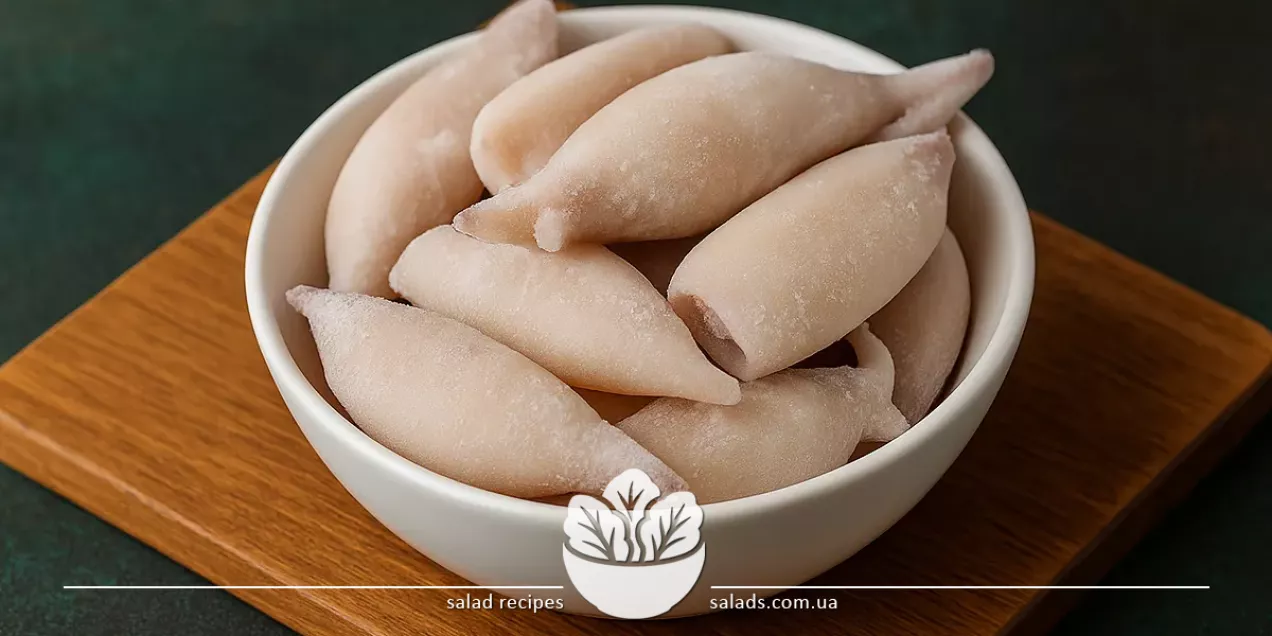
Frozen Squid

Frozen squid is a convenient way to store and use one of the most popular seafood items in everyday meals. Frozen squid retains most of its beneficial properties and flavor qualities, requires no complex preparation, and its neutral taste allows for experimenting with a variety of sauces and spices. In dishes, it pairs well with vegetables, grains, and dairy products, forming balanced and nutritious combinations. You can learn more about other squid in this section.
Salad Recipes with Frozen Squid
Nutritional Value and Benefits of Frozen Squid
Squid is not only delicious but also an extremely nutritious seafood, known for its high content of protein, vitamins, and minerals. One hundred grams of squid contains about 16 grams of protein, minimal fat, and only around 80 kcal, making it a great option for a dietary and balanced diet. It also contains valuable micronutrients such as iodine, zinc, copper, selenium, and B-group vitamins, especially B12, which supports the nervous system. Particularly valuable is the presence of amino acids like taurine, which helps reduce cholesterol levels and strengthens the cardiovascular system. Thanks to this composition, frozen squid is recommended for people watching their weight, engaging in active sports, or recovering from illness. Squid is easy to digest, doesn’t burden the digestive system, and doesn’t cause a feeling of heaviness. When combined with other nutritious ingredients, squid can serve not only as an addition but also as the foundation of a complete dish. For example, in salads, it pairs well with canned corn, creating a pleasant contrast in texture and highlighting the gentle flavor of the seafood.
How to Properly Thaw and Cook Squid
The key to tasty and tender squid dishes is proper thawing and cooking. The best method is to thaw squid slowly in the refrigerator for 8-10 hours. This approach helps preserve texture and flavor. If quicker thawing is needed, cold water can be used, but never hot or warm water – it can ruin the meat's structure. After thawing, squid should be peeled, with the cartilage and internal organs removed if still present. Boiling time should not exceed 1-2 minutes; otherwise, the meat becomes tough and rubbery. Ideal preparation methods include quick frying, blanching, or baking at high temperatures. If squid is cooked longer (e.g., in stewed dishes), cooking time should exceed 30-40 minutes so the meat becomes tender again. To enhance flavor, spices, lemon juice, or garlic are often used, bringing out the squid’s marine character. In more intense recipes, squid pairs well with ingredients like fresh carrot, which adds color, sweet notes, and crunchy texture.
Salads and Cold Starters with Squid
Frozen squid is an ideal ingredient for making salads and cold appetizers. Thanks to its delicate flavor and soft texture, it pairs well with vegetables, eggs, grains, and dairy products. One of the classic options is a salad with squid, egg, and mayonnaise, which can be varied by adding fresh herbs, cucumbers, or sweet corn. A more modern approach includes salads with lemon dressing, olive oil, whole grain mustard, and a mix of leafy greens. In festive menus, squid is often served as stuffed rolls: after blanching, the bodies are filled with vegetables, cheese, mushrooms, or even caviar. They are served chilled with sauce or a light side. Another popular option is savory tartlets or canapés, where squid is paired with cheese, herbs, and spicy sauces. An interesting addition to salads can be ingredients with pronounced taste and texture. For instance, the gentle flavor of squid is well balanced by products like boiled chicken eggs, which add satiety and textural harmony to the dish.
What to Pair Squid With: Good Combinations and Alternatives
Squid has a delicate taste that easily adapts to many ingredients. In salads, it pairs well with vegetables, eggs, herbs, and dairy products, creating both light and more filling dishes. In hot recipes, squid is often combined with grains, creamy sauces, tomatoes, or mushrooms. It’s important to maintain balance – squid quickly absorbs flavors, so overly salty or strongly spiced components should be avoided. Basic combinations include squid with stewed vegetables, rice, or cream sauce. In such dishes, squid maintains its tenderness and structure, adding lightness to the meal. In salads, it can be combined with boiled potatoes or canned corn – these ingredients add satiety without heaviness. If squid is unavailable, it can be replaced with other seafood with a similar texture. For example, a great alternative is boiled shrimp, which also cooks quickly, has a delicate flavor, and is used in similar dishes.